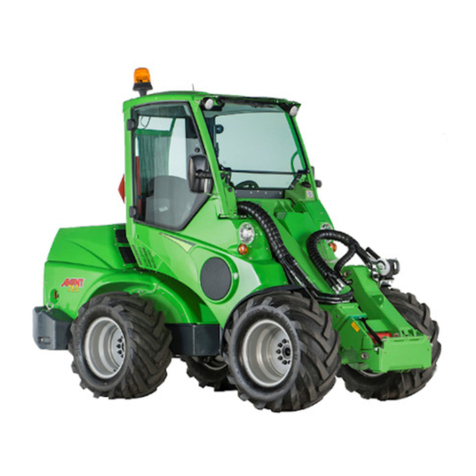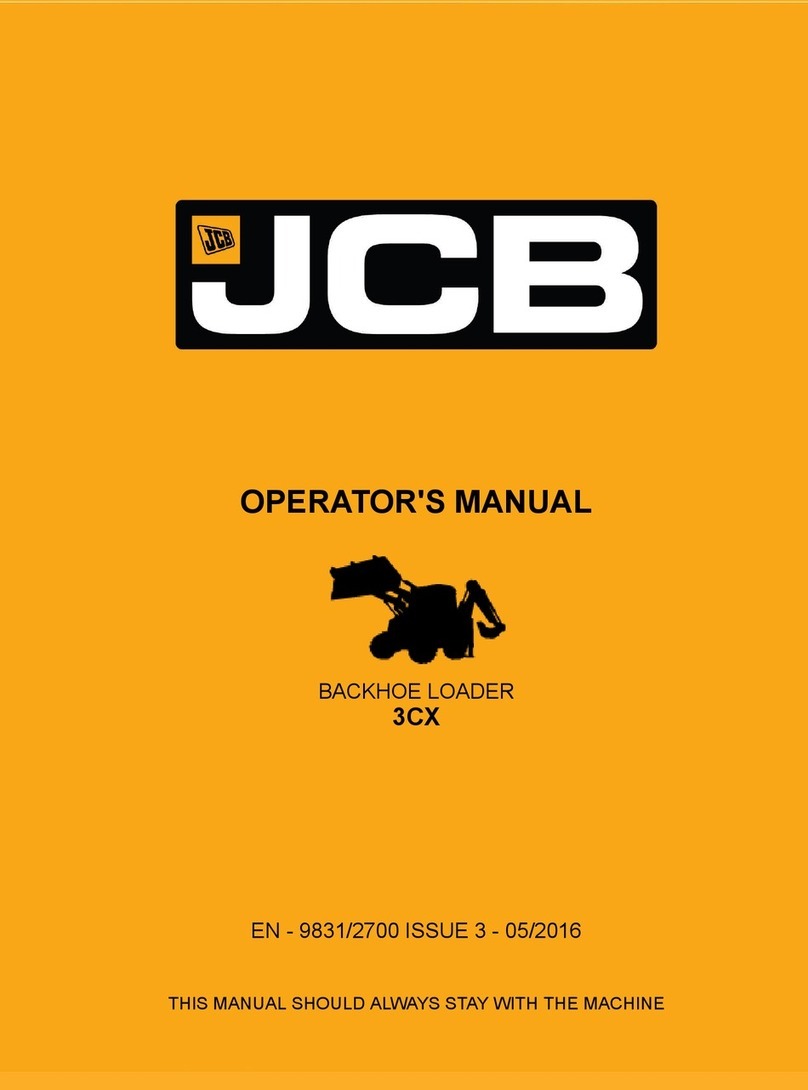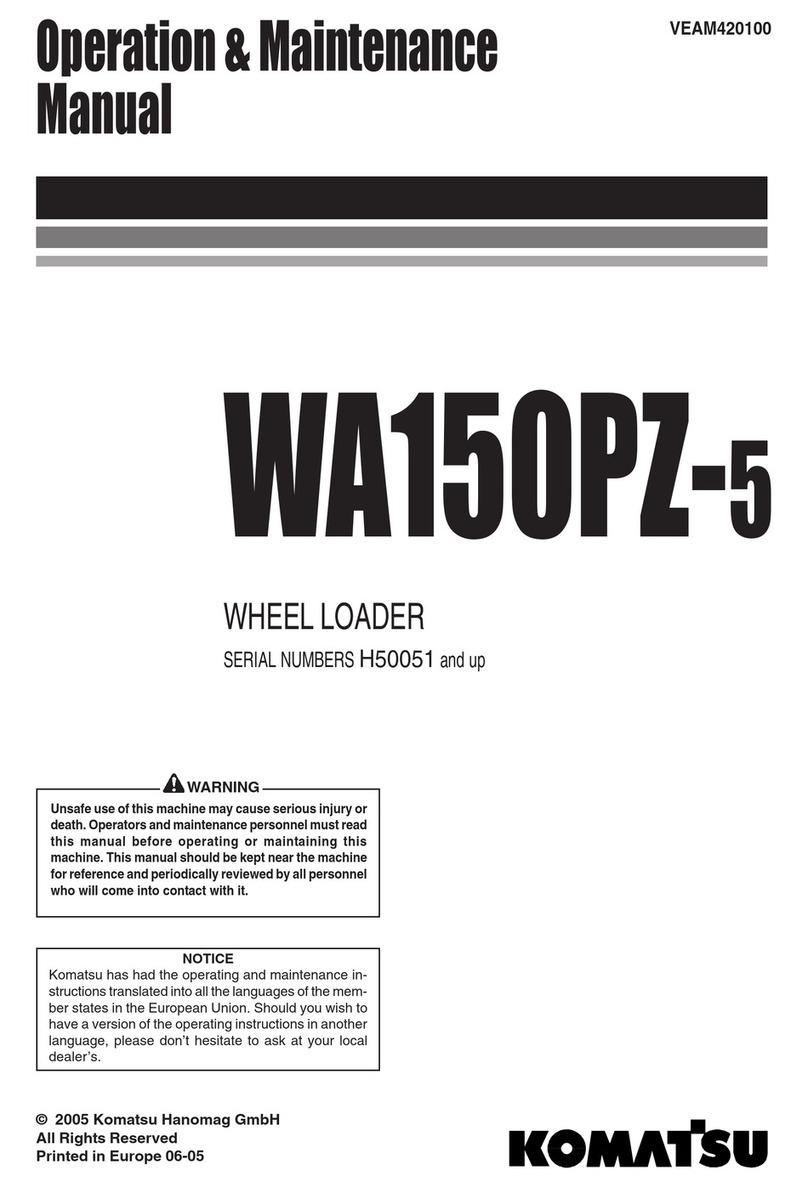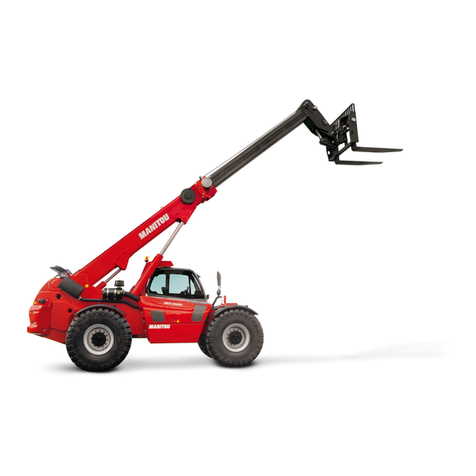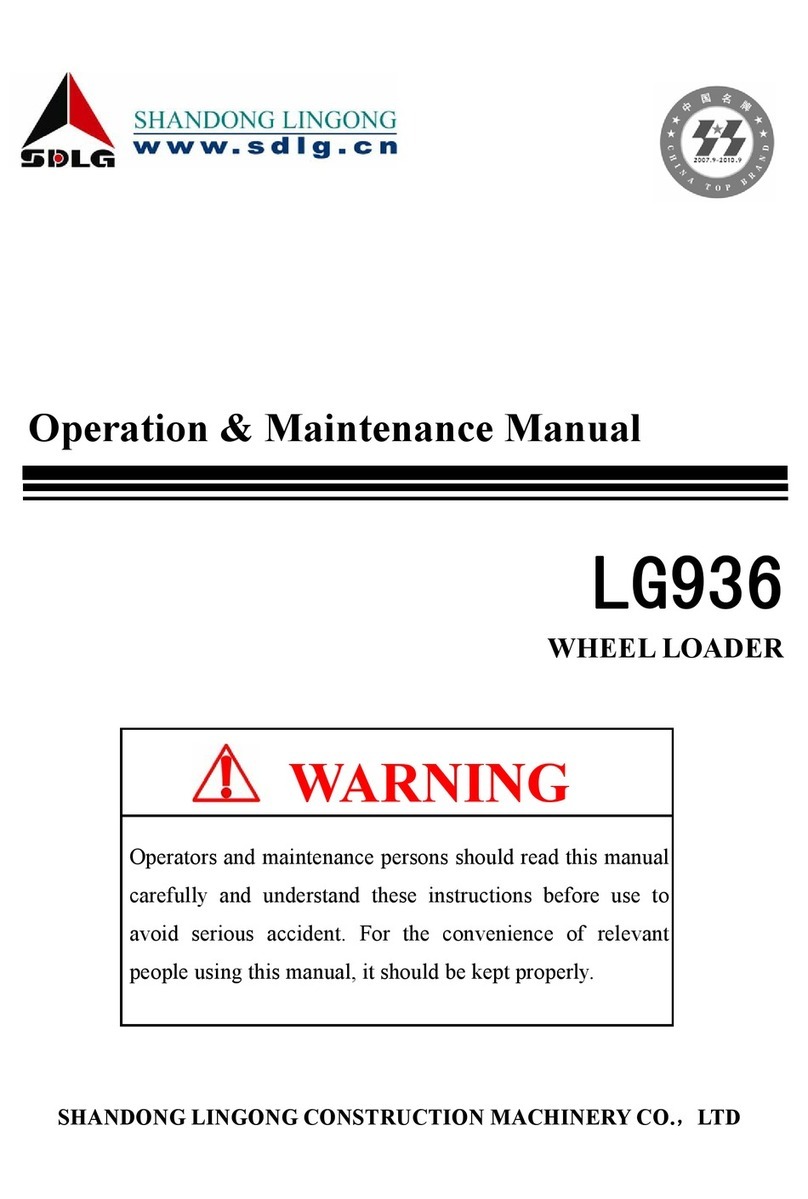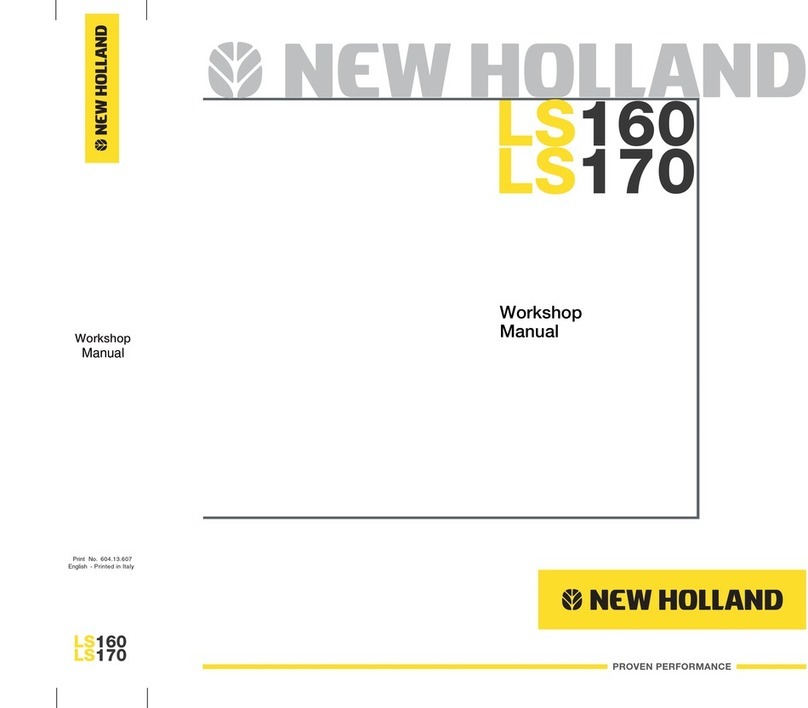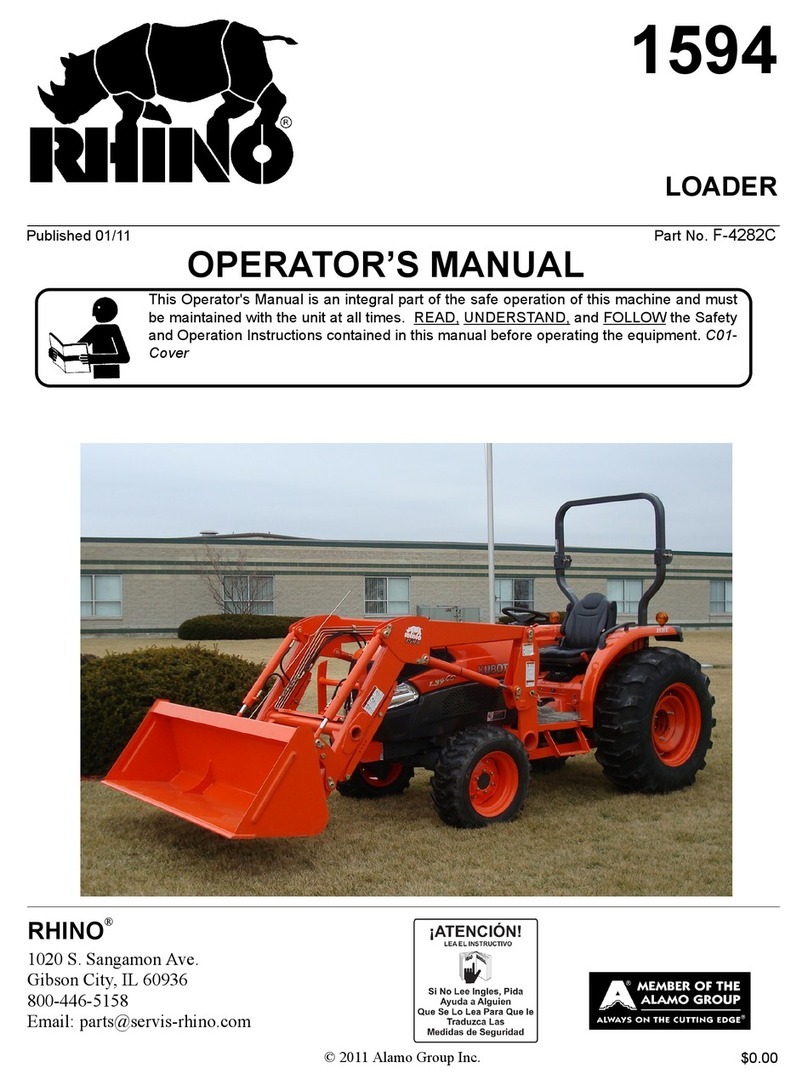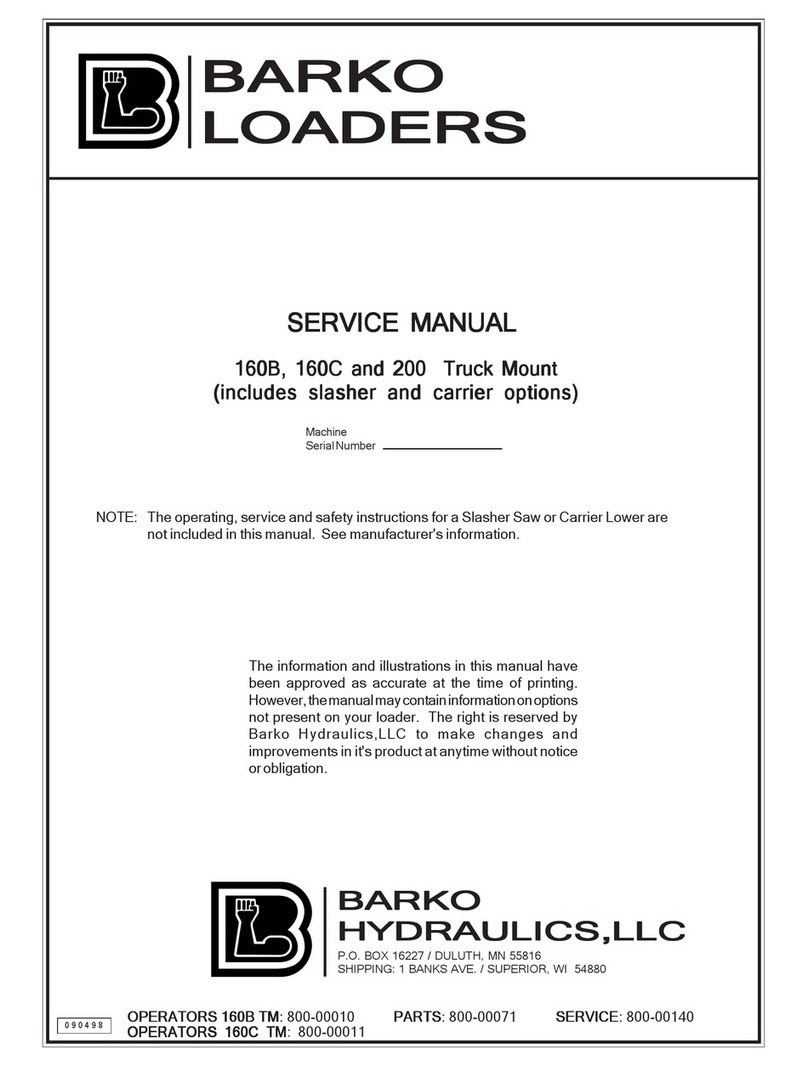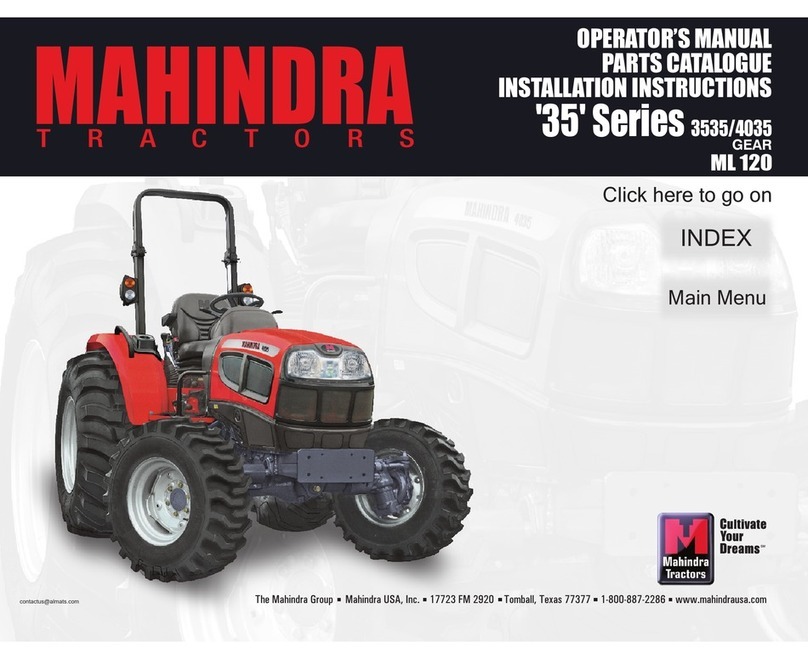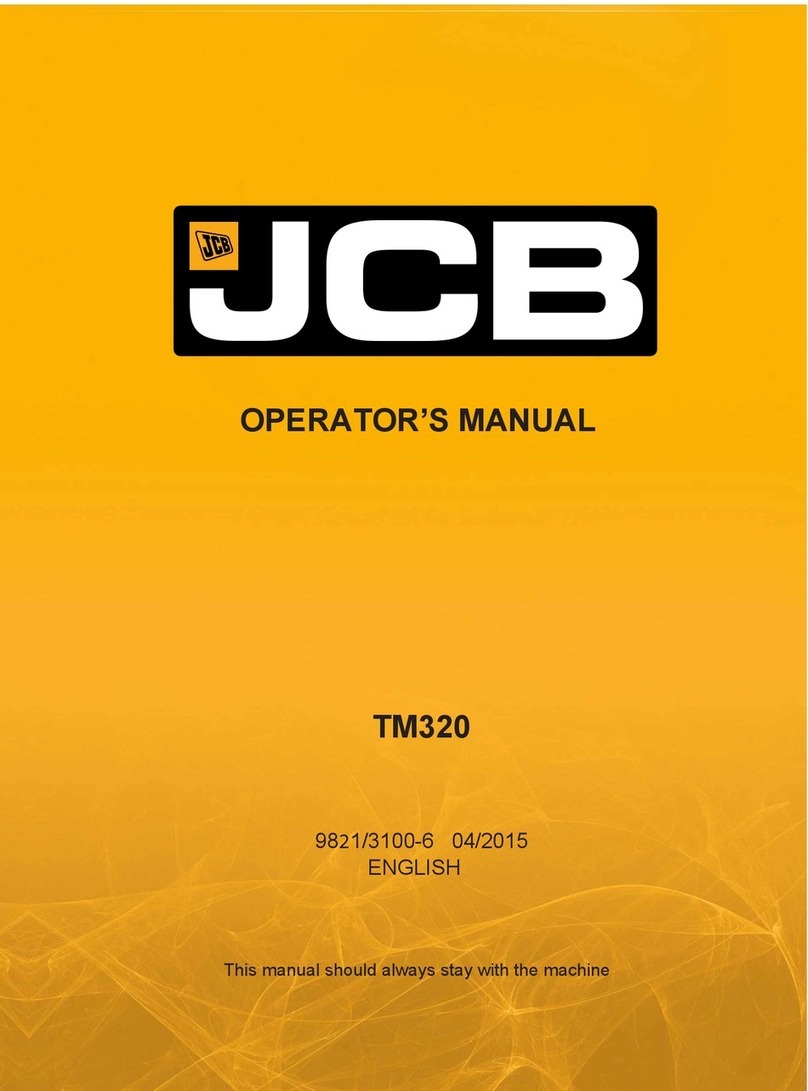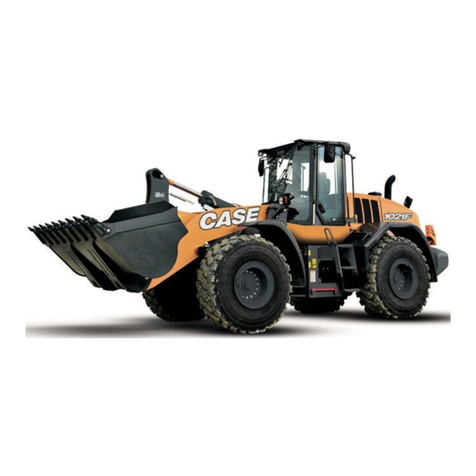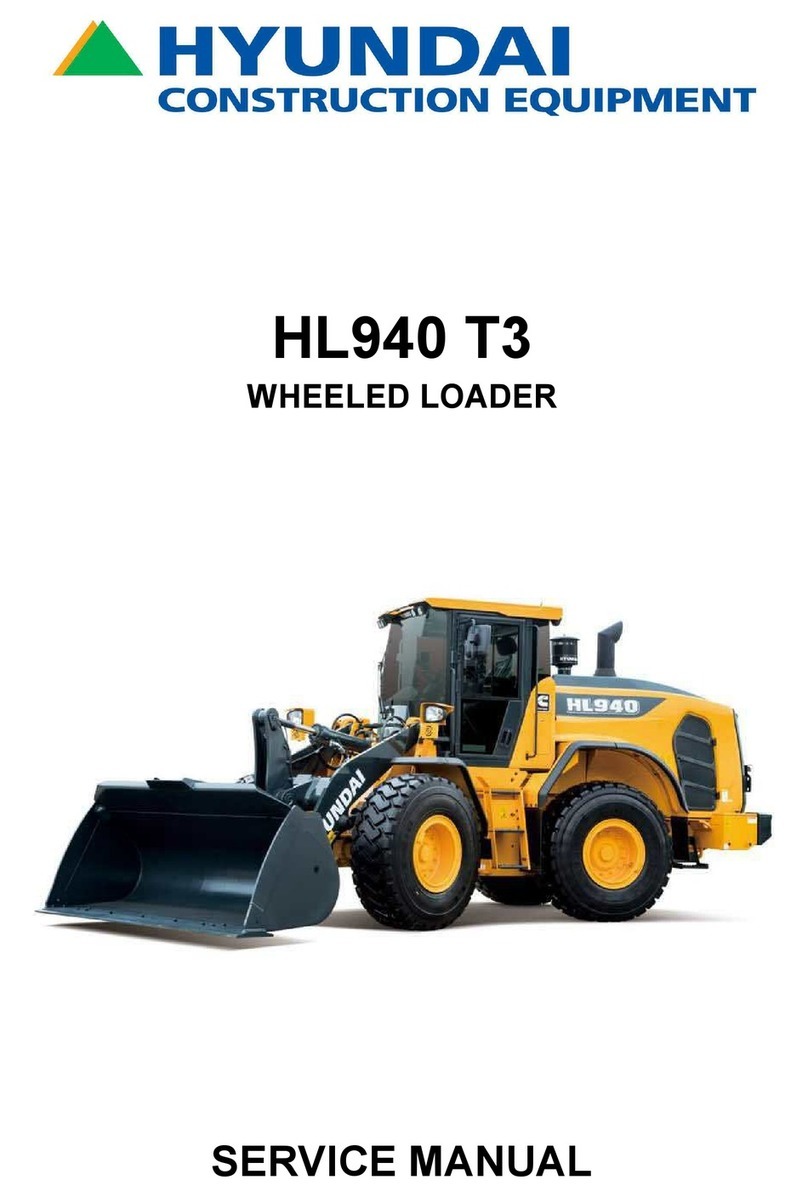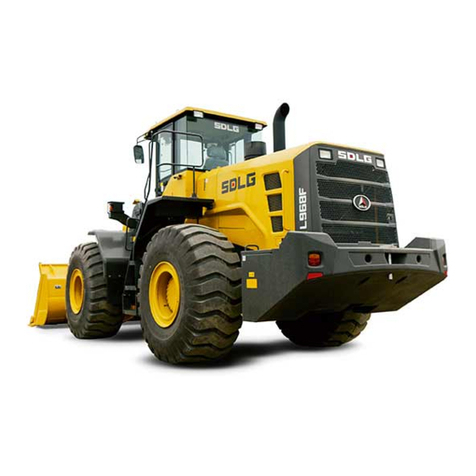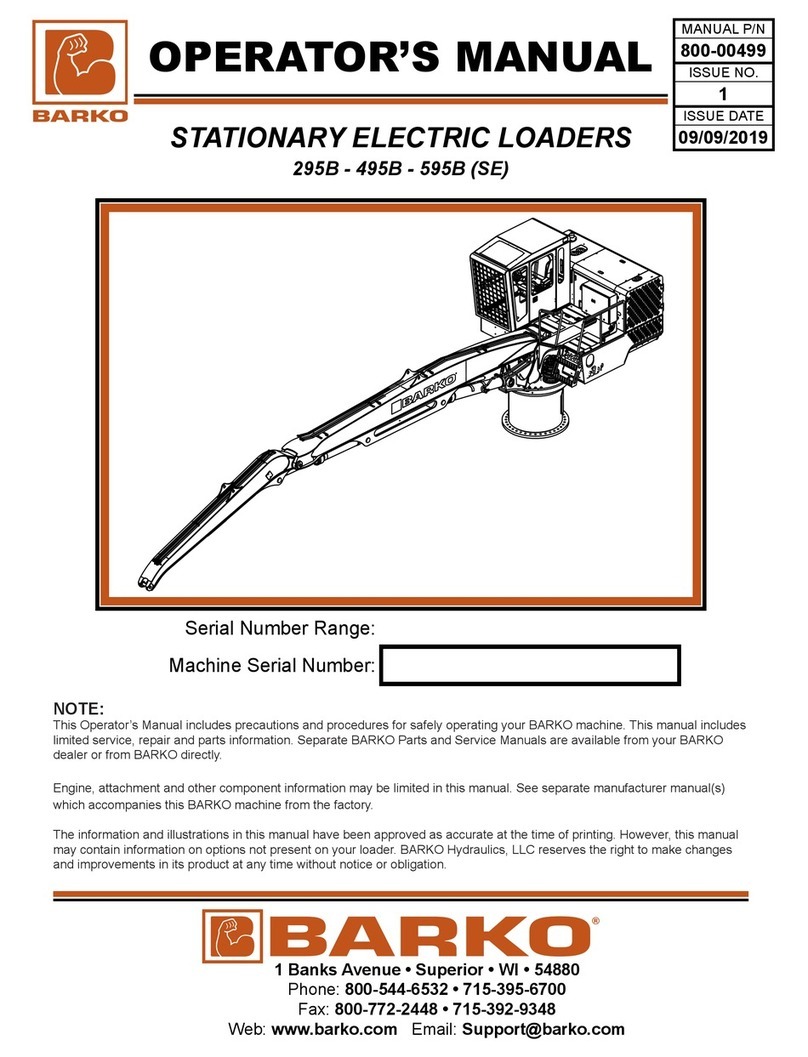Blue Giant BG1 User manual

OWNER’S MANUAL
BG1TASK SUPPORT VEHICLE
WARNING
Do not operate or service this product unless you have
read and fully understand the entire contents of this
manual. Failure to do so may result in property damage,
bodily injury or death.
ISSUE DATE: DECEMBER 7, 2020 REV.1.0 (PART # 038-XXXXE)
ACTUAL PRODUCT MAY NOT APPEAR EXACTLY AS SHOWN

WARNING
Do not operate this vehicle unless you have been
authorized and trained to do so, and have read all
warnings and instructions in Operator’s Manual and on
this vehicle. Read, understand and comply with the
information on the vehicle’s nameplate at all times.
Do not operate this vehicle until you have performed
the daily operation’s check list. Verify and inspect tires,
horn, battery, controller, lift and hydraulic systems,
brakes, steering mechanism and guards. Verify that all
emergency controls, personal protection and safety
devices are in place and functioning correctly and
ensure the vehicle is free of fluid leaks and has no
loose or missing parts. Report any problems to the
designated authority and do not use the vehicle until
they are corrected by a qualified mechanic.
This vehicle must not be modified without the
manufacturer’s consent. Components critical to the
vehicles stability such as batteries shall not be
replaced with lighter weight components.
Operate vehicle only from designated platform
operating position. Use this vehicle indoors on level
surfaces only. Never operate on ramps and slopes or
uneven floors. This vehicle is not for use on
mezzanines or balcony areas. Before operating,
inspect the floor area it will be used on and be certain it
will support the vehicle at full capacity and lift height.
Identify and avoid holes, drop-offs, bumps and
obstructions.
Before and during all vehicle operations ensure that
adequate clearance is maintained from overhead
obstructions and energized electrical conductors and
parts.
Before elevating platform be sure guardrail access
gates are in place and lowered. Keep feet on platform
floor at all times while using vehicle, never climb onto
guard rails or platform shelf. Do not use ladders,
planks or other devices to achieve additional height on
platform.
When transferring loads to platform or platform shelf,
do not exceed capacity ratings on vehicle nameplate.
Ensure loads are centered and do not contact any
obstructions in the vehicle’s vicinity. Do not stabilize
the platform by contact with adjacent objects such as
racks or shelving. Do not use the platform as a crane.
Take care to prevent electrical cords, hoses or other
equipment from entangling in platform. Ensure area
surrounding the vehicle is free of personnel and
equipment before lowering platform.
Maintain a clear view of the ground while travelling
and a safe distance from obstacles in the vehicle or
platform’s path. Ensure personnel in the vicinity are
aware of the vehicle’s movement. Travel at a safe
speed for the conditions the vehicle is operating in.
Observe applicable traffic regulations. Yield right of
way to pedestrians. Slow down and sound horn at
cross aisles and wherever vision is obstructed. Avoid
hazardous locations.
Enter and exit platform only through raised access
gates and with the platform fully lowered and vehicle
stopped. When leaving vehicle unattended, remove
key to prevent unauthorized use.
2

Section Page Section Page
1 DESCRIPTION ...................................................1-1
1-1 INTRODUCTION ........................................1-1
1-2 GENERAL DESCRIPTION .........................1-1
1-3 DATA PLATE AND WARNING DECAL......1-2
1-4 INSTALL /WARRANTY CHECK LIST ........1-2
2 PLANNED MAINTENANCE................................2-1
2-1 GENERAL...................................................2-1
2-2 MONTHLY AND QUARTERLY CHECKS...2-1
2-3 FREQUENT INSPECTIONS.......................2-1
2-4 ANNUAL INSPECTIONS............................2-1
2-5 BATTERY CARE .......................................2-1
2-5.1 GENERAL ..........................................2-1
2-5.2 SAFETY RULES .................................2-2
2-5.3 MAINTENANCE PERSONNEL...........2-2
2-5.4 BATTERY CARE AND CHARGING ...2-2
2-5.5 BATTERY CLEANING ........................2-2
2-5.6 MAINTENANCE FREE BATTERIES ..2-2
2-6 CHARGING BATTERIES ...........................2-3
2-7 REPLACING BATTERIES ..........................2-3
2-7.1 BATTERY DISPOSAL ........................2-3
2-8 LUBRICATION............................................2-4
2-9 LIFT CHAIN MAINTENANCE. ....................2-4
3 TROUBLESHOOTING........................................3-1
3-1 GENERAL...................................................3-1
3-2 CONTROLLER TROUBLESHOOTING ......3-4
3-2.1 ZAPI HANDSET..................................3-4
3-2.2 FAULT DETECTION...........................3-4
3-2.2.1 GENERAL......................................3-4
3-2.2.2 LOGBOOK ACCESS .....................3-4
3-2.3 TESTING TRUCK OPERATION.........3-4
3-2.4 FACTORY SETTINGS........................3-5
4 STEERING SYSTEM..........................................4-1
4-1 CONTROL ARM .........................................4-1
4-1.1 STEERING CONTROL REMOVAL ....4-1
4-1.2 STEERING CONTROL
INSTALLATION ..................................4-2
4-2 COMPARTMENT COVER..........................4-2
4-2.1 COVER REMOVAL.............................4-2
4-2.2 COVER INSTALLATION.....................4-2
4-3 STEER MOTOR .........................................4-2
4-3.1 MOTOR REMOVAL ............................4-2
4-3.2 MOTOR INSTALLATION. ...................4-3
5 BRAKE SERVICING...........................................5-1
5-1 BRAKES .....................................................5-1
5-1.1 BRAKE ASSY. REPLACEMENT ........5-1
6 TRANSMISSION, DRIVE WHEEL,
LOAD WHEEL AND CASTERS..........................6-1
6-1 TRANSMISSION AND DRIVE MOTOR. ....6-1
6-2 LOAD WHEEL. ...........................................6-2
6-2.1 REMOVAL ..........................................6-2
6-2.2 INSTALLATION ..................................6-2
6-3 DRIVE WHEEL ...........................................6-2
6-4 CASTER. ....................................................6-2
7 ELEVATION SYSTEM SERVICING ...................7-1
7-1 GENERAL...................................................7-1
7-2 LIFT CHAIN LENGTH ADJUSTMENT .......7-1
7-3 LIFT CHAIN WEAR INSPECTION .............7-2
7-4 LIFT CHAIN REPLACEMENT ....................7-2
7-4-.1 THREE STAGE MAST........................7-2
7-4.1.1 MAST LIFTING CHAIN..................7-2
7-4.1.2 PLATFORM LIFTING CHAIN ........7-2
LIFT CYLINDERS. 7
HYDRAULIC SYSTEM SERVICING 1
LINES AND FITTINGS 1
HYDRAULIC PUMP, MOTOR, AND RESERVOIR
ASSY 1
REMOVAL 1
DISASSEMBLY AND REASSEMBLY 1
INSTALLATION 3
LIFT CYLINDER (FULL FREE LIFT) 3
REMOVAL 3
REPAIR 3
INSTALLATION 3
LIFT CYLINDER (THREE STAGE MAST SECOND-
ARY) 8
REMOVAL 8
REPAIR 8
INSTALLATION 9
ELECTRICAL COMPONENTS 1
ELECTRICAL CONTROL PANEL 1
MAINTENANCE 1
CLEANING 1
PANEL REMOVAL. 1
PANEL DISASSEMBLY. 1
PANEL INSTALLATION. 1
HORN REPLACEMENT. 1
LOWERING BUZZER REPLACEMENT. 3
LEVEL SENSOR BUZZER REPLACEMENT. 3
LEVEL SENSOR REPLACEMENT. 3
WARNING LIGHT REPLACEMENT. 3
BATTERY REPLACEMENT. 3
BATTERY CHARGER. 3
REMOVAL. 3
INSTALLATION. 3
PLATFORM CABLE REPLACEMENT.. 4
THREE STAGE MAST 4
OPTIONAL EQUIPMENT 1
INDUSTRIAL BATTERY 1
ILLUSTRATED PARTS BREAKDOWN 1
3

4

SECTION 1
DESCRIPTION
1-1. INTRODUCTION.
This publication describes the 24 volt BG1 task
support vehicle by Blue Giant. Included are planned
maintenance instructions, lubrication procedures,
corrective maintenance procedures and a complete
parts list with part location illustrations.
Users shall comply with all requirements indicated in
applicable OSHA standards and the current edition of
A.N.S.I. A92.6. By following these requirements and
the recommendations contained in this manual, you
will receive many years of dependable service from
your BG1 task support vehicle.
1-2. GENERAL DESCRIPTION.
The self-propelled BG1 task support vehicle lifts
and transports up to 1,000 pounds capacity
including load and operator. The vehicle enables
general maintenance work and efficient selection
and moving of materials in any area or at any level of
the warehouse or storeroom. This vehicle is not for
use on mezzanines or balcony areas. The design
permits one man to perform all operations of
selecting stock, driving vehicle, and replacing the
stock at the designated place. The battery-powered
vehicle is quiet and allows operation in closed areas
without special provisions for ventilation.
Figure 1-1 BG1 Elevating Work Platform
R6980
ITEM COMPONENT
1 Control arms
2 Pick tray
3 Warning light
4 Cover
5 Control panel
6Casters
7 Frame
8 Drive wheel
9 Hydraulic pump and
reservoir
10 Battery retainer
11 Battery
12 “Deadman” footswitch
13 Operator platform
14 Load wheels
15 Side gates
16 Rear tray for additional capacity and
storage
17 Mast
ITEM COMPONENT
5

1-3. DATA PLATE AND WARNING DECAL.
Blue
Giant
1-4.INSTALLATION / WARRANTY CHECK LIST.
Blue Giant
initiate
.
e
Blue
Giant
Figure 1-2 BG1 Data Plate
R6978
6

Warranty Claim Form
ATTN: WARRANTY MANAGER Email: customersupport@bluegiant.com
Dealer ID # Dealer Name Claim Form Date (MM/DD/YYYY)
Has Unit Been Maintained / Lubricated as Specified in Accordance with Owner’s Manual?
Yes No
Equipment Model # Serial # Customer
Date of Equipment Sale (MM/DD/YY) Hour Meter Reading Customer Address
Equipment Purchase Invoice # Dealer Repair Order # City / State / Province
Submitted By (Print Full Name) Title Zip / Postal Code
Phone: Fax: Email:
Labor Total Hours: Rate: Labor Total: $ Start Date
(MM/DD/YY)
Travel Total Hours: Rate: Labor Total: $ Start Date
(MM/DD/YY)
Description of Fault:
Nature of Fault:
Corrective Procedure (Full Details Required, Incomplete Information will Delay Process)
Blue Giant Part # Part Description QTY. Blue Giant Replacement
Part(s) Invoice Number(s) Price Total
$$
$$
$$
$$
$$
Freight P E The totals calculated on this form are estimates only. Warranty guidelines may apply. Final totals will appear on your
warranty invoice. Please go to www.BlueGiant.com for Warranty Coverage and Warranty Guidelines for your product. $$
GL # WC # RGA#
A confirmation receipt will be faxed back with a warranty claim number attached. If Blue Giant deems that part(s) need to be returned, an RGA numbered form
will be faxed as well. Please include a copy of the RGA form with returning part(s) to Blue Giant Brampton location only.
0.00
0.00
0.00
0.00
0.00
0.00
0
0

NOTES
8

SECTION 2
PLANNED MAINTENANCE
2-1. GENERAL.
Planned maintenance consists of periodic visual and
operational checks, inspection, lubrication, and
scheduled maintenance designed to catch an issue in
the early hours or discover malfunctions and
defective parts. The operator performs the checks in
the Operator’s Manual, and refers any required
servicing to a qualified maintenance technician who
performs the planned maintenance and any required
servicing.
2-2. MONTHLY AND QUARTERLY CHECKS.
Table 2-1 is a monthly and quarterly inspection and
service chart based on normal usage of equipment
eight hours per day, five days per week. If the vehicle
is used in excess of forty hours per week, the
frequency of inspection and service should be
increased accordingly. These procedures must be
performed by a qualified service technician or your
Blue Giant Ser-vice Representative.
2-3. FREQUENT INSPECTIONS.
The owner and user are required by ANSI A92.6 to
ensure frequent inspections of the BG1 Task Support
Vehicle occur and are performed in accordance with
the following points: 1. If purchased used unless it's
determined that the frequent and annual inspections
are current. 2. The BG1 Task Support Vehicle has
been in service for three (3 months or 150 hours,
whichever comes first. 3. The BG1 Task Support
Vehicle has been out of service for a period longer
than three (3 months. inspection is to be performed
by a mechanic that is qualified and authorized to
perform service on the BG1 Task Support Vehicle. All
service records must be maintained.
2-4. ANNUAL INSPECTIONS.
The owner and user are required by ANSI A92.6 to
ensure annual inspections of the BG1 Task
Support Vehicle occur and are performed no
later than 13 months from the date of prior
annual inspection or every 700 hundred hours
of use, whichever occurs first. This annual
inspection is to be performed by a mechanic that
is qualified and authorized to perform service on
the BG1 Task Support Vehicle. All service
records must be maintained.
2-5. BATTERY CARE.
2-5.1. General
The vehicle may be equipped with maintenance free
batteries.
The care and maintenance of the battery is very
important to obtain efficient vehicle operation and
maximum battery life.
CAUTION: Gases produced by a battery can be
explosive. Do not smoke, use an open
flame, create an arc or sparks in the
vicinity of the battery. Ventilate an
enclosed area well when charging.
CAUTION: Batteries contain sulfuric acid which may
cause severe burns. Avoid contact with
eyes, skin or clothing. In case of contact,
flush immediately and thoroughly with
clean water. Obtain medical attention
when eyes are affected. A baking soda
solution (one pound to one gallon of
water) applied to spilled acid until
bubbling stops, neutralizes the acid for
safe
Table 2-1 Monthly and Quarterly Inspection and Service Chart
VISUAL CHECKS
INTERVAL INSPECTION OR SERVICE
Monthly Check electrical brake for proper operation.
Monthly Inspect wiring for loose connections and damaged insulation.
Monthly Check wheels for wear and damage.
Monthly Check "deadman” footswitch for proper operation.
Monthly Check lift chain tension, lubrication & operation (see paragraph 2-9.)
Quarterly Check lift cylinder for leakage.
Quarterly Test electric steering.
Quarterly Check steering gear for wear and lubricate.
Semi-annually Inspect for chain wear (See SECTION 7)
9

2-5.2. Safety Rules
• Wear protective clothing, such as rubber apron,
gloves, boots and goggles when performing any
maintenance on batteries. Do not allow electrolyte to
come in contact with eyes, skin, clothing or floor. If
electrolyte comes in contact with eyes, flush
immediately and thoroughly with clean water.
Obtain medi-cal attention immediately. Should
electrolyte be spilled on skin, rinse promptly with
clean water and wash with soap. A baking soda
solution (one pound to one gallon of water) will
neutralize acid spilled on clothing, floor or any
other surface. Apply solution until bubbing stops
and rinse with clean water.
•Do not bring any type of flame, spark, etc., near the
battery. Gas formed while the battery is
charging, is highly explosive. This gas remains in
cell long after charging has stopped.
•Do not lay metallic or conductive objects on battery.
Arcing will result.
• Do not touch non-insulated parts of DC output
connector or battery terminals to avoid possible
electrical shock.
•Disconnect all AC and DC power connections before
servicing battery.
•Do not charge a frozen battery.
• Do not use charger if it has been dropped or
otherwise damaged.
2-5.3. Maintenance Personnel
Batteries may only be charged, serviced or replaced
by trained personnel. This manual and the
manufacturer’s instructions concerning batteries and
charging stations must be observed when carrying out
the work.
2-5.4. Battery Care and Charging
CAUTION: Never smoke or bring open flame near
the battery. Gas formed during charging
is highly explosive and can cause
serious injury.
1. Charge the battery only in areas designated for
that use.
2. Battery terminals should be checked and cleaned
of corrosion regularly. Good battery terminal
contact is essential not only for operation, but also
for proper charging of the battery.
3. Make certain battery used meets weight and size
requirements of vehicle. NEVER operate vehicle
with an undersized battery.
2-5.5. Battery Cleaning
Always keep vent plugs tightly in place when cleaning
battery. When properly watered and charged, the
battery will remain clean and dry. All that is
necessary is to brush or blow off any dust or dirt
that may accumulate on them. However, if electrolyte
is spilled or over-flows from a cell, it should be
neutralized with a solution of baking soda and
water, brushing the soda solution beneath the
connectors and removing grime from the covers.
Then rinse the battery with cool water from a low
pressure supply to remove the soda and loosen dirt.
If batteries stay wet consistently, they may be either
overcharged or over filled. This condition should be
investigated and corrected.
2-5.6. MAINTENANCE FREE BATTERIES
Some vehicles may be equipped with maintenance
free batteries. These batteries are completely sealed,
will not require any watering and have a full 80%
discharge available.
Sealed Maintenance Free batteries contain a pressure
release valve and under normal operating conditions
do not require any special ventilation.
CAUTION: Do not try to open this battery or remove
the pressure release valve.
Only under severe overcharging, such as connected
to an improperly sized charger, will any significant
amount of gases be released from the battery. Also,
being a valve regulated battery, it never requires
watering.
10

2-6. CHARGING BATTERIES
Charging requirements will vary depending on depth of
discharge and temperature. Follow safety rules when
placing a battery on charge.
Proceed as follows:
1. Park vehicle at charging station with platform
lowered and turn the key switch OFF.
2. Apply the emergency disconnect switch.
3. Check the condition of the AC cord and battery
cables. If there are any cuts in the cable, any
exposed wires, loose plugs or connectors, DO
NOT attempt to charge the batteries.
4. Disconnect plug (1, Figure 2-1) from the vehicle
and connect it to charger’s plug (2).
5.
6.
Connect cord (3) and charge the battery
according to Supplement 374 *.
Disconnect the charger cord and insert it in its
receptacle on the vehicle.
Figure 2-1 Battery Charging
2-7. REPLACING BATTERIES
Replace only with original OEM batteries or batteries
approved by an authorized Blue Giant dealer.
Contact your authorized Blue Giant dealer for
information on optional batteries and battery chargers.
1. Park vehicle at charging station with platform
lowered and turn the key switch OFF.
2. Apply the emergency parking brake.
3. Disconnect the battery from the vehicle and place
the battery plug and cable in such a way that they
will not get caught on the vehicle when the battery
is removed.
4. Remove retainer (2, Figure 2-2).
WARNING: Take caution when removing the battery
pack or optional industrial battery from
the vehicle. Battery is located on battery
rollers. Use of a battery stand is
recommended when removing the
battery. Only an authorized
Blue Giant dealer should be used
for battery removal and installation.
5. Remove battery (1) out the side of the vehicle.
6. Install in reverse order.
WARNING: The weight and dimensions of the
battery have considerable affect on
the operational safety of the vehicle.
Battery equipment may only be replaced
with the agreement of the manufacturer.
Figure 2-2 Battery Replacement
2-7.1. Battery disposal:
Dispose in accordance with national environmental
protection regulations or disposal laws. The
manufacturer’s disposal instructions must be followed
R6986
R6987
11

2-8. LUBRICATION.
Refer to Table 2-2 for the recommended types of
grease and oil. Table 2-3 in conjunction with
Figure 2-3 identifies the items requiring lubrication.
2-9. LIFT CHAIN MAINTENANCE.
Fully raise and lower lift carriage while observing
chains as they move over chain sheaves. Ensure
chain is aligned and tracking properly and all links are
pivoting freely. With lift carriage fully lowered, spray on
a film of Moly Chain Lube. For more information see
SECTION 7
Table 2-2 Recommended Lubricants
(See Table 2-3 for Application)
R6115
No. 1 Grease—Polylub GA352P
No. 2 Hydraulic oil—L-HM46#.
12

Figure 2-3 Lubrication Diagram
Table 2-3 Lubrication Chart
FIG 3-2
INDEX
NO.
LOCATION METHOD OF
APPLICATION
TYPE
(Table
2-3)
APPLICATION
OF
LUBRICANT
1 Mast Spray No. 1
2 Hydraulic Reservoir Can No. 2
Full length of channel where rollers
operate.
With platform fully lowered, fill
reservoir with hydraulic oil to
level on dip stick.
R6988
13

VERSION G PAGE 1 OF 2
MODEL: SERIAL:
P F C
P F C
Instrument panel is clean and free of debris and dash display is funconal.
Operator leside control arm steering wheel func properly.
Emergency lower buon operates properly.
Ensure gate switches disable travel/liand lower funcons and g lights on the front and rear of
the vehicle.
HOUR METER:
BATTERY SPEC.: OPTIONS: PREVIOUS INSPECTION:
Plarm guard rails are undamaged and gates open / close freely.
Chains are adequately lubricated and are not dry or rusty.
Mast cover plates are in place and securely hed for each secon.
Coned on page 2
FREQUENT INSPECTIONS: The owner anduser are required by ANSI A92.6 to ensure frequent inspec of the BG1 Task
Support Vehicle occur and are performed in accordance with the following points: 1. If purchased used unless it's determined
that the frequent andannual inspec are current. 2. The BG1 Task Support Vehicle hasbeen in service for three (3)
months or 150 hours, whichever comes rst. 3. The BG1 Task Support Vehicle has been out of service for a periodlonger than
three (3) months. inspec is to be performed by a mechanic that is ed andauthorized to perform service on the BG1
Task Support Vehicle. Allservice records must be maintained.
INSPECTION REQUIREMENTS per ANSI A92.6 (ANNUAL AND FREQUENT)
ANNUAL INSPECTION:The owner and user are required by ANSI A92.6 to ensure annual inspec of the BG1 Task Support
Vehicle occur andare performed no later than 13 months from the dateof prior annual inspec or every 700hundred hours
of use, whichever occurs rst. This annual inspec is to be performed by a mechanic that is ed andauthorized to
perform service on the BG1 Task Support Vehicle. Allservice records must be maintained.
NOITAMROFNIRESUDNE/RENWONOITAMROFNIRELAED
COMPANY:
ADDRESS:
Annual Inspec�on Report
INSTRUCTIONS: Refer to service/maintenance manuals for specc informa regarding inspec procedures and criteria.
Indicate in the appropriate space as each item has been performed. If the item is found to be not acceptable, describe each
discrepancy on an addi page and aach to the form. Immediate acon must be taken to correct all discrepancies. The
vehicle shall not be placed in service un all discrepancies have been corrected.
CITY/STATE/ZIP:
COMPANY:
ADDRESS:
CITY/STATE/ZIP:
MAST SIZE:
VEHICLE INFORMATION:
Operator right side control arm funcons properly. Horn / travel / li/ lower / accelerator buons are
func.
Put a in the column that applies: P= Passed Inspec�on , F = Failed Inspec�on, C = Corrected
Drive and operate machine to test all funcons. Ensure controls operate properly and return to "" or
neutral when released.
Ensure emergency power disconnect switch deactes all movement and power and that the deadman
foot switch operate properly.
FUNCTIONS and CONTROLS
Mast sec are free of visual evidence of damage. Mast chains and cables are inspected per the
Service and Maintenance Manual.
OPERATOR PLATFORM ASSEMBLIES
The drive wheel returns to "neutral" (straight forward) when powering up the vehicle and is accurately
depicted on the LCD display.
All nuts, bolts, pins, shas, covers, bearings and wear pads are checked for proper installa, and do
not have excessive wear, cracks or distoron.
Mast wiring harnesses are properly installed, seated in their pulleys and that there are no frayed or
broken strands.
Mast operates smoothly to full height and descends smoothly. Ensure speed cutbacks occur at
appropriate heights per the maintenance manual.
Page 2-6
14

VERSION G PAGE 2 OF 2
Annual Inspecon Report
MODEL: SERIAL:
P F C
P F C
P F C
P F C
HYDRAULIC SYSTEM
DEALER: OWNER / END USER:
Ensure stability pads at base of unit (adjacent to caster wheels) are intact, properly secured and have
not sustained any damage
Ensure the electronic brake operates properly.
GENERAL
Ensure paint is in good condi and that there are not any issues with the overall appearance of the
task support vehicle.
Grease and lubricate the mast channel per maintenance manual.
Ensure baery level is correct (if applicable).
Visually inspect motors to ensure there is no damage.
Ensure baery charger scrolls through diagnoscs when plugged in.
Ensure all electrical connec are ght, free of frays and corrosion.
Ensure baery meets weight and voltage requirements.
Ensure level is correct in hydraulic tank.
Ensure hydraulic pump is secure and undamaged, operates properly and is free of leaks.
Ensure hydraulic control valve is secure and undamaged, operates properly and is free of leaks.
Ensure hydraulic oil breather/vented cap is clean, hydraulic tank cap is ght and vent is open.
POWER and DRIVE SYSTEM
The undersigned cees that this machine has been inspected, per each area of inspec and any and all discrepancies have been
brought to the enon of the Owner / User, and that all discrepancies have beencorrected prior to any further use of this machine.
Inspect front and rear load trays for funconality and damage.
MANUALS - DECALS - DATA PLATE
DATE:
OWNER / USER
SIGNATURE:
OWNER / USER
PRINTED NAME: DATE:
DEALER
SIGNATURE:
DEALER
PRINTED NAME:
Ensure ANSI/ SIA A92.6 manual of responsibilies, opera manual and service manual are in weather
resistant pouch on vehicle.
Ensure data plate is in place, secured and legible
Ensure all instrucon and safety decals are installed, secure and legible.
ADDITIONAL COMMENTS
Licylinder is free of damage, no evidence of leaks and that all hardware is secure and undamaged.
All hydraulic hoses, gs and components are properly secured and that there is no evidence of leaks.
VEHICLE INFORMATION:
MAST SIZE: HOUR METER:
Ensure oponal equipment such as anchor point, tether, full body harness and tow hitch are in good
condi and fully funconal (if applicable).
Inspect overall structural condi including welds.
Verify that no unauthorized ca or addi have been made.
Ensure drive, load and caster wheels are properly installed, secure and do not have excessive wear.
Ensure all e wheels have contact with the oor.
Page 2-7
15

NOTES
16

SECTION 3
TROUBLESHOOTING
3-1. GENERAL
Use Table 3-1 as a guide to determine possible
causes of trouble. The table is divided into five main
categories: Vehicle and Hydraulic System Will Not
Operate: Vehicle Does Not Operate Forward or
Reverse: Trouble With Braking: Trouble With Lifting Or
Lowering, and Miscellaneous malfunctions.
Table 3-1 Troubleshooting Chart
MALFUNCTION PROBABLE CAUSE CORRECTIVE ACTION
TRAVEL AND HYDRAULIC
SYSTEM WILL NOT OPERATE
Check the battery connector and
connect if necessary.
Turn keyswitch “ON” or bypass
keyswitch to determine if it is
malfunctioning.
Close safety guard rail.
Disengage the emergency power
disconnect switch or bypass
switch to determine if it is
malfunctioning.
Press "deadman" footswitch or
bypass pedal to determine if it is
malfunctioning.
a. Battery connector not
connected.
b. Keyswitch “OFF” or defective.
c. Safety guard rail open.
d. Emergency power disconnect
switch pressed or defective.
e. “Deadman” footswitch not
pressed or defective.
f. Battery charge too low.
g. Faulty fuse.
Check battery charge, charge
battery if necessary.
Test fuses.
VEHICLE DOES NOT OPERATE
FORWARD OR REVERSE
Vehicle does not travel forward or
reverse. All other functions
operate normally.
a. Check all wiring. A loose con-
nection may be the cause of
malfunction.
Tighten all loose connections
before further troubleshooting.
c. Defective controller.
d. Defective travel switch.
Vehicle travels forward but not in
reverse.
Defective travel switch.
Vehicle travels reverse but not in
forward.
Defective travel switch.
Vehicle travels forward and in
reverse at lower speeds; will not
travel at high speed.
a. Defective travel switch in
control head.
b. Operator platform raised above
47 inches.
Check for proper operation and
replace if necessary.
Check and replace switch if
defective.
Check and replace switch if
defective.
Check and replace switch if
defective.
Check and replace switch if
defective.
Lower operator platform below 47
inches
17

Table 3-1 Troubleshooting Chart - Continued
MALFUNCTION PROBABLE CAUSE CORRECTIVE ACTION
TROUBLE WITH LIFTING OR
LOWERING
Oil sprays or flows from the top of
the lift cylinder.
Defective packing in lift cylinder Repair lift cylinder.
Squealing sounds when lifting
Operator’s platform.
Identify oil leak and fill reservoir.
Apply grease.
a. Oil level too low.
b. Dry channels in mast.
c. Defective mast or Platform
rollers
Replace rollers.
Forks do not lift to top. a. Oil level too low. Add oil to reservoir.
b. Load larger than capacity. Refer to I.D.plate for capacity.
Weak, slow or uneven action of
hydraulic system.
a. Defective pump or relief valve. Check pressure. Adjust as
necessary.
b. Worn lift cylinder. Replace cylinder.
c. Load larger than capacity. Refer to I.D.platefor capacity.
d. Defective lift motor relay. Replace relay on pump motor.
e. Battery charge low. Charge battery.
Platform does not lift, pump motor
does not run.
Check and recharge if required.
Check and repair as required.
a. Battery is dead or
disconnected.
b. Defective wiring.
c. Defect in electrical system for
operating pump motor.
Check lift switch in control head,
as well as the relay.
Platform does not lift, motor runs. Defect in hydraulic system. Check the oil level in the reservoir
and the oil lines to the lift
cylinder, and repair as required.
If normal, check the hydraulic
pump, and relief valve. Repair, or
adjust.
Platform lifts, but will not go down. Defect in hydraulic system Check lowering control switch and
lowering solenoid. Replace as
required.
Load will not hold Replace valve assembly.
a. Oil bypassing internally in
control valve
b. Worn lift cylinder or packing. Repack cylinder.
Platform does not lift to top. Pump
motor runs.
a. Oil level too low. Add oil to reservoir.
b. Load larger than capacity. Refer to nameplate on side of
mast for maximum load capacity.
c. Batteries need charging. Charge batteries.
18

Table 3-1 Troubleshooting Chart - Continued
MALFUNCTION PROBABLE CAUSE CORRECTIVE ACTION
TROUBLE WITH LIFTING OR
LOWERING - Continued
Forks drifts down under load when
in a raised position.
Leak in hydraulic system, lift cylin-
der or lowering valve.
Check for leaking fitting in
hydraulic line and repair as
required. Repack lift cylinder
or replace valve assembly.
TROUBLE WITH STEERING
Test fuses.
Tighten all loose connections
before further troubleshooting.
Check and replace potentiometer
if defective.
Check for proper operation and
replace if necessary.
a. Faulty fuse.
b. Check all wiring. A loose
connection may be the cause
of malfunction.
c. Defective potentiometer.
d. Defective controller.
e. Defective steer motor.Replace if necessary.
19

3-2. CONTROLLER TROUBLESHOOTING
3-2.1. Zapi Handset
A Zapi Handset is available that is designed
specifically for use with the Zapi controller. It serves
multiple functions of reading diagnostic data,
testing truck operation, setting options, adjustments
and parameter changes of the controller. The Zapi
Handset is avail-able through your Blue Giant
dealer. If you require dealer location information,
contact Blue Giant.
Remove the rubber plug from the CNC connector of
the controller Figure 3-1 and plug in the Zapi
Handset connector.
Figure 3-1 Zapi Controller
3-2.2. Fault Detection.
3-2.2.1. General
The microprocessor in the controller records the last
five Alarms that have occurred. Items remembered
relative to each Alarm are:
• The alarm code
• The times that each alarm occurs consecutively
• The Hour Meter value when the latest event of every
alarm occurred
This function permits a deeper diagnosis of problems
as the recent history can be revisited.
3-2.2.2. Logbook Access
To view the alarm logbook proceed as follows:
1. Connect the Zapi Handset, refer to paragraph
3-2.1.
2. Press the ENTER button (3, Figure 3-2) to enter
the MAIN MENU.
3. Press the ROLL down button (2) or the ROLL up
button (1) until ALARMS menu appears on the
display.
4. Press the ENTER button (3) to enter the ALARMS
menu.
5. Press the ROLL up button (1) to view the alarms.
Pressing the ROLL down button (2) returns to the
most recent alarm.
If an alarm has not occurred, the display will show
NONE.
6. Press the OUT button (4) to exit the alarms. The
display will ask: “CLEAR LOGBOOK?” Press the
ENTER button (3) for Yes or OUT button (4) for
No.
7. Press the OUT button (4) again to return to
Opening Zapi Menu.
3-2.3. Testing Truck Operation.
The Zapi Handset can be used to test certain truck
operations as follows:
1. Connect the Zapi Handset, refer to paragraph
3-2.1.
2. Press the ENTER button (3, Figure 3-2) to enter
the MAIN MENU.
3. Press the ROLL down button (2) or the ROLL up
button (1) to find the TESTER display.
4. Press the ENTER button (3) to enter the TESTER
function.
The first switch to be tested is shown on the
display.
5. To verify various switch functions, press the ROLL
down button (2) or the ROLL up button (1) to
locate the switch on the display and then operate
that function to verify operation
6. Press the OUT button (6) to exit the tests. The
display will show TESTER.
7. Press the OUT button (6) again to return to
Opening Zapi Menu.
R6628
20
Other manuals for BG1
1
Table of contents
